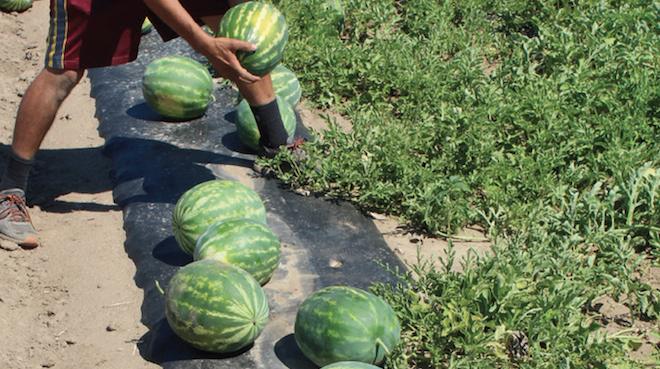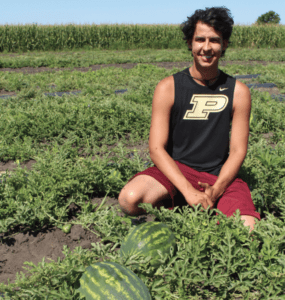

Jun 1, 2021IPM brings higher watermelon yields
A field of watermelons can produce a more than a 25% higher yield under an integrated pest management (IPM) program than a program of a soil-drench insecticide at planting, followed by a sequence of foliar insecticides later in the season. That’s the conclusion of a new three-year study at Purdue University.
Dramatically improved pollination was the main reason for the higher yields under IPM, and the striped cucumber beetle numbers in the fields managed by IPM were rarely over the treatment threshold.
The watermelons in the three-year study were grown in half-acre plots planted in 15-acre fields of corn. The watermelon plots were moved to a different site in the corn fields every year, so every plot only had watermelon in one year of the study.
Setting up a study
The Midwest is corn country with watermelon crops regularly surrounded by corn. To simulate that cropping system, researchers compared the effects that a neonicotinoid seed treatment will have on the corn and the watermelon crop that it surrounds.
“We needed these large, realistically-sized fields if we’re going to make a recommendation to growers,” said Jacob Pecenka, Purdue graduate student involved in the study with Ian Kaplan, Purdue entomology professor.
The conventional watermelon program was a neonicotinoid soil drench at transplanting, plus four foliar applications of a pyrethroid over the season on a planned sequence. The watermelons grown under IPM didn’t receive any insecticide treatment at planting and would only receive a foliar application if scouting revealed that pests – primarily striped cucumber beetle – reached economically damaging levels.
The conventional program evaluated in the corn was a neonicotinoid seed treatment. The seed in the IPM program for corn was not treated. Insect pests, pollinators and yield were all measured.


“These factors are all significantly connected,” Pecenka said. “We wanted to make this research as realistic as possible and as beneficial to a grower as we can. We wanted as complete of a picture as possible of what was going on in these fields.”
Insect pests in the conventional and IPM watermelon plots were monitored weekly. Striped cucumber beetle was the primary pest of concern and was the most frequently encountered pest.
The watermelons in the conventional program averaged 0.11 striped cucumber beetles per plant at all sites during all three years. This was consistently lower than the economic threshold for treatment of five beetles per plant.
The watermelons in the IPM program averaged 1.18 striped cucumber beetles per plant over the three years and rarely reached the economic threshold for treatment. When a threshold was reached, a single spray provided effective control.
“One insecticide spray was enough to knock their numbers down for the rest of the year through harvest,”
Pecenka said.
However, the conventionally managed watermelon fields did have one instance where an outbreak of aphids reached high enough levels to require an additional insecticide treatment.
The apparent difference was beneficial insects.
“It was easy to find aphids; they secrete honeydew,” Pecenka said. “We’d mark the aphids’ location. We’d go back, and in the IPM plots we’d see lots of lady beetles and lady beetle larvae feeding on them. We’d also see lots of parasitized aphids.”
Corn comparison
In the corn trial, across all sites
and years there was no difference in the number of plants that emerged between the corn with a neonicotinoid seed treatment and the corn that wasn’t treated.
The insect pests that hurt stands – like black cutworm that attack emerging seedlings and wireworm, and seed corn maggot that feed on the seed – do not show up every year.
“These are very sporadic pests,” Pecenka said. “Every once in a while, they pop up. Throughout Indiana they’re just not a consistent threat.”
The amount of late season corn rootworm damage was also evaluated. The study area was planted to corn the year before beginning the three-year trial. This meant continuous corn for four years.
In the first three years, there was hardly any observable damage to the plant roots sampled. In the fourth year, the corn grown under IPM had damage severe enough to cause some lodging, but not enough to cause a statistically significant yield loss.
“Four years of continuous corn is a pretty long window,” Pecenka said. “Normally, if you start to find a problem with a pest like corn rootworm, you would rotate to a crop like soybeans. We wanted to limit the number of variables, so this study only looked at corn with or without the seed treatment and didn’t look at rotation.”
As a result of these findings, researchers couldn’t find a statistically significant difference in yield and found no financial benefit from the use of a neonicotinoid seed treatment on any of the corn.
“Is there a yield benefit from the seed treatment?” Pecenka asked. “In Indiana, Purdue researchers don’t see one, and researchers throughout the Midwest have found similar findings.”
Pollination benefits
There was significantly higher pollinator activity in the watermelons managed by IPM and surrounded by corn grown without the seed treatment. Two honeybee hives were placed in every watermelon plot. During the bloom period of between five and nine weeks after transplanting, pollinator visits to the plots were almost 130% more frequent in the IPM program than in the conventional program. The IPM fields also had more visits from native bees.
“We measured the levels of insecticide in the pollen,” Pecenka said. “There was enough to be lethal or have sublethal effects.”
Sublethal effects include the insect pollinators not being able to fly as well, losing navigation and the ability to return to their hives, and not being able to produce young.
“The foliar insecticide applications also had a repellent effect,” Pecenka said.
Pollination visits to individual flowers were more than 300% higher in the IPM plots compared to the conventionally managed watermelons. This was largely due to pollinator behavioral differences between the conventionally and IPM-managed fields.
RELATED: Watermelon biomass, yield compete with morningglory››
In the IPM plots, honeybees were observed moving from flower to flower, making repeated pollinator visits. In the conventional plots, researchers observed that a bee would land on one flower and then leave the field.
“That’s where the repellent effects of the insecticides was a factor,” Pecenka said.
Pollinator health in the IPM plots was also significantly improved with the honeybee colonies having a higher brood production, faster brood growth, lower at-hive mortality and better overwinter survival.
The 26% higher yield of the IPM watermelons was estimated to increase income by more than $2,000 per acre. This does not take into account the higher insecticide cost of the conventionally managed program and any higher, hive rental costs due to poor hive performance.
— Dean Peterson, VGN correspondent














